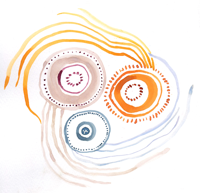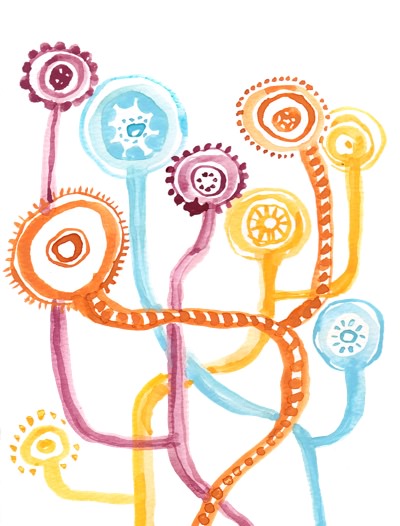Bridging Divides – The Art of Collaborative Community Conversations

One of the most powerful things art can do for a community is to help make sense of what’s going on around us. Creating art is about sharing stories, expressing oneself, and offering fresh perspectives.
Q: What happens when you bring a diverse group of people together and invite them to be in conversation with each other, to share their stories and perspectives, learn from one another, and discuss pressing issues in the community?
A: An opportunity presents itself to create a collective perspective and reveal shared values and priorities.
This type of collective sensemaking is a much needed community art form that can help build trust, bridge divides, and strengthen community resiliency. It’s uplifting when community members come together and discover that they actually agree on things. Too often we’re pitted against each other; differently informed, we’re baited, triggered, and react from a place of fear.
The typical town hall meeting format consists of a series of monologues, first by “experts”, and then by community members. Each speaker has a few minutes to express their perspective, and then it’s on to the next. Very little sense making or clarity around where there’s agreement gets accomplished at these meetings.
A Collaborative Community Conversation is different.
| Collaborative Community Conversation | Typical Town Hall Meeting |
| Diverse Participation Effort is made to identify, recruit, and get in the room, a demographically representative sample of the community. Attention is paid to having a diversity of perspectives at each table. | Random Participation Whoever hears about the meeting attends. Often it’s folks with special interests who may not be thinking about what’s best for the community as a whole. |
| Dialogue Participants spend a high percentage of the meeting in small group dialogue, sharing perspectives, learning from each other and discovering common ground. | Serial Monologue Participants get a short amount of time to share whatever they want with the whole room. |
| Focused Questions Questions are thoughtfully crafted to get the specific kind of input that will be valuable to the convenors. | Random Thoughts Participants are allowed to speak about whatever it is; whether it’s relevant or not. |
| Rapid Sense Making Ideas from all discussions are recorded and transmitted to a group who is reading in real-time, distilling out the key themes and crafting clear statements that reflect the thinking of the whole group | Confusion It’s difficult to keep track of the different perspectives that emerge from a series of short monologues from individuals that speak about whatever they want. |
| Discussion of Themes & Prioritization The group’s thinking is presented back to participants for reflection and potential prioritization. This allows you to rapidly identify the most important issues the group identifies on the topics that are most important to convenors. | A lot of ideas with no clarity Conveners are left to make sense of the variety of perspectives they’ve heard. Loud voices are amplified while marginalized voices are often left out. |

People in dialogue about topics of importance to them, properly facilitated, can help the group see things that were difficult to see – areas of agreement, outliers, and shared priorities. The key is to put participants into small groups, give them a focused questions to discuss, have a facilitator to capture the ideas that emerge, and a team to review the ideas that come from all groups and identify the key themes from across all of the conversations.
It’s in this synthesis process where the art takes form. Diverse ideas come in and a group works together to understand and articulate the various perspectives. These ideas get presented back to the whole group for reflection, validation and prioritization. The result is a clearer understanding of a wide range of responses to the question(s) being posed as well as where there is agreement.
Participants in these types of conversations appreciate the opportunity to truly participate and to feel seen and heard. Even if their ideas don’t end up as top priorities, they see that the process was transparent, fair, and they are more likely to support the outcomes.
“This type of open communication with government is 100% effective and respected by residents within the community. Great Summit truly appreciated.”
Summit Participant – West Palm Beach Mayor’s Task Force for Racial & Ethnic Equality Action Summit
There are so many issues facing our communities that we need to talk about. Unfortunately we are at a time of great polarization on many issues, making it difficult to find common ground. This polarization can lead to decision makers feeling it’s dangerous and unproductive to engage with the community.
In my 25+ years of experience working on these types of Collaborative Community Conversations; exploring issues such as healthcare, balancing the federal budget, racial equality, and numerous citywide strategic planning efforts, I’ve seen very few instances of grandstanding, yelling, or name calling.
Collaborative Community Conversations are creative, productive, and help the community to find areas of shared understanding. Decision makers get clarity around the various perspectives and priorities the community has on the questions and issues that are of most importance to them. Hundreds of participants can participate in these conversations and they can be run just as effectively virtually or in-person. This type of collaborative sense-making is just what communities need to address some of the complex challenges they face together.
“Community insight and wisdom are, and always will be, the pre-eminent sources of creativity and innovation about how social cohesion, civic renewal, and restoration of the ideals of healthier democracy can be advanced.”
From American Academy of Arts and Sciences “Creating A Sustainable Civic Infrastructure”
